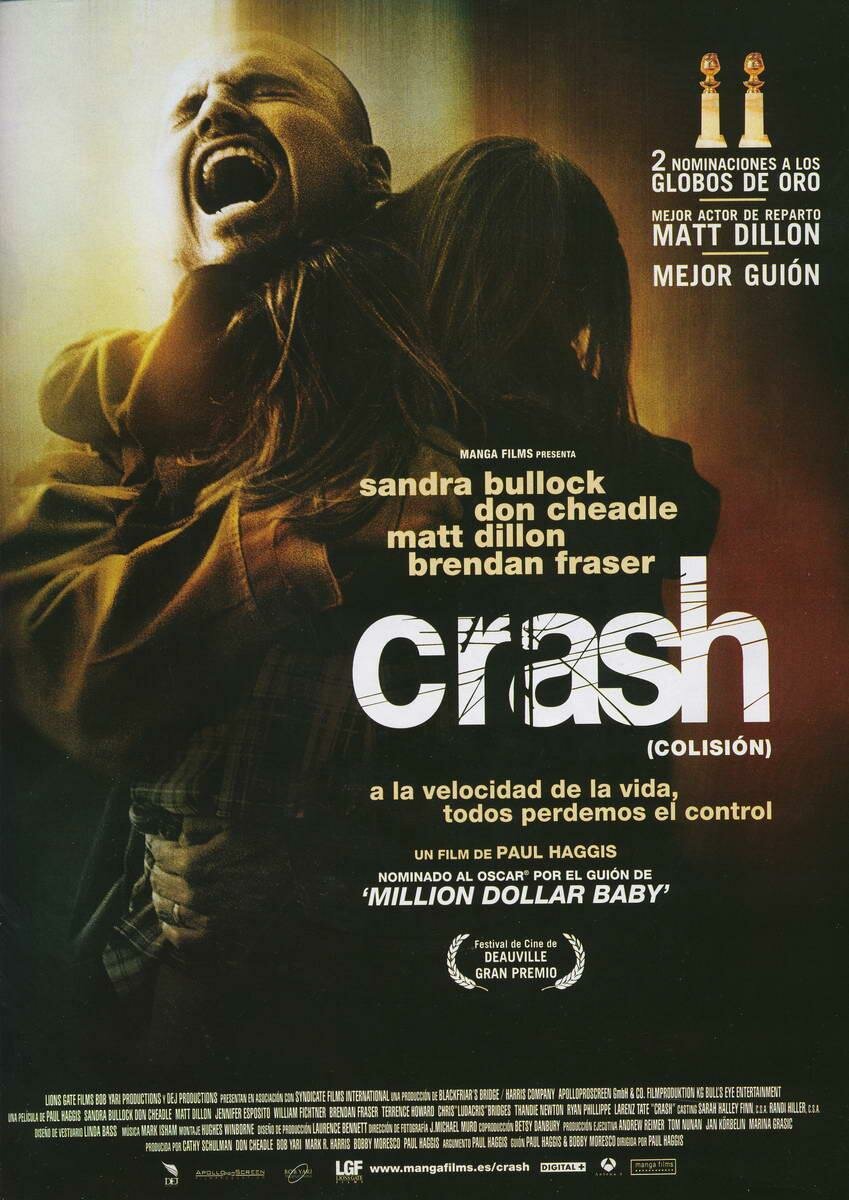The Oscars are long over, and not a few commentators were of the opinion that the latest Best Picture Winner, Green Book, was the worst film to claim the prize since Crash, way back in 2005. Not a great comparison to be sure, but think about it this way: In our outrage-driven culture, and against ever-more virtue-signaling efforts like The Shape of Water and Moonlight, Crash somehow managed to hold the title of Worst Best Picture Ever for 14 years.
Who could be responsible for creating such a divisive disaster? Why, Canadian filmmaker Paul Haggis, of course. But don’t blame him for everything: not even he would have selected his own film as worthy of the nod. The Academy made their decision, but all he wanted to do with Crash was generate a reaction, and in that respect, he succeeded brilliantly. (Was he trying to troll further by giving his film the same name as Cronenberg’s Crash? No one will ever know.)
There’s nothing revelatory about Haggis’ Crash, just like there’s nothing really ground-breaking about the other films Haggis has directed, or the TV shows he’s written for. He created Walker, Texas Ranger, that workhorse of syndication TV. He masterminded the Gritty Reboot of James Bond with Daniel Craig in the lead role, by making clear what everyone else already knew about 007 – that he is a broken, hollow shell of a man, unable to form deep connections with anyone. He’s buddies with Clint Eastwood of all people, pairing with him for another Oscar-winning film, Million Dollar Baby. And, in a nod to his Canadian roots, he gave us Due South– an utterly by-the-numbers buddy cop procedural which pairs a comically straight and preternaturally gifted Mountie, Benton Fraser, and his deaf pet wolf Diefenbaker, with your basic schlubby Chicago detective, Ray Vecchio. (By the way, Mounties do not have pet wolves like Jon Snow from Game of Thrones, and they do not go absolutely everywhere in those full-dress red uniforms, any more than a Navy SEAL would wear their full dress blues in active combat.)
I’m going to come right out and say it: Paul Haggis is to movies what Nickelback is to music. In Haggis’ mind, he is making deep and resonant films about race, war (he’s also responsible for The Valley of Elah, one of countless early-oughts Iraq War Fallout films) and speaking to unspoken truths that nobody will confront. And he does have his admirers – people who unironically love Chuck Norris’ karate-kicking cowboy antics and think the show is THE antidote to cultural Marxism, and those who have memed Norris into the literal personification of Christ, and those Canadians who love to see Paul Gross’ straight-shooting Mountie show up his cynical American colleagues. And there’s nothing wrong with after-school TV. But Haggis is trying to make revelatory, convention-smashing art and edge-of-your-seat TV, and most of what he ends up making is Cheez Whiz. Remember the furor over Craig’s “Blond Bond,” and remember how everyone had mostly lost interest by the time Quantum of Solace came out?
So, what is the reason for this gap between Haggis’ reach and his grasp? Very simply: His idea of what is controversial or groundbreaking is very, very Canadian. He’s a Benton Fraser, a modern-day Sergeant Preston of the Yukon in a world of hard-boiled Americans. He is talented, but he promises more than he delivers. He understands that the world is harsh and brutal and often meaningless, but he has no way to empathize with those affected by it, and as such his work comes off as glib and superficial to many. It certainly pays the bills, though, and gets people to react.
We’ll close out our series on Canadian directors next week with a family dynasty of filmmakers- the Reitmans- who have their own unique, and uniquely Canadian, approach to the brutality and meaningless of life: Ignore it completely.
*****
See the previous installments in the series:
Part 1 on Heroes: ‘Scott Pilgrim Vs The World’ Vs Terrance Denby and ‘Sidequest’
Part 2 on “Humour”: The Libertarian Fantasy of ‘Letterkenny’
Part 3 on Graphic Novel Nihilism: The Harsh Truths of ‘Essex County’
Part 4 on Spawn and Wolverine: Banished From The Promised Land: A Tale of Two Canadian Anti-Heroes
Part 5 on Science Fiction Dystopias: Inside Quebec’s – and Canada’s – Replicant Culture
Part 6 on Animation: The Garrison Mentality: More Than Meets The Eye
Part 7 on Pop Music: How To Build A Successful Canadian Musical Act
Part 8 on Anne of Green Gables and The Traumatized Artist: Lucy Maud Montgomery’s Treacherous Alpine Path
Part 9 on Avoiding the Serious: Mordecai Richler, Montreal, And Gritty Realism
Part 10 on Southern Ontario Gothic: The Marriage of the Mundane and the Fantastic
Part 11 on Margaret Atwood’s Reign of Terror: Literary Tyranny and The Handmaid’s Tale
Part 12 on the First Nations Fraud: Whitewashing Genocide: Truth, Lies, and Joseph Boyden
Part 13 on the inventive Esi Edugyan: A Novel I Cannot Recommend Enough
Part 14 on Generation X Origins: Douglas Coupland And The Hopeful (?) Future Of Canadian (?) Culture
Part 15 on Jordan Peterson Rising: Canadian Culture Creators And The Intellectual Dark Web
Part 16 on The Awkward Quiet: David Cronenberg’s Silent Hell
Part 17 on The Saddest Music In The World: Guy Maddin’s Surrealist Madness
Part 18 on Ararat: Atom Egoyan’s Stammering Grief



Comments
Leave a Reply